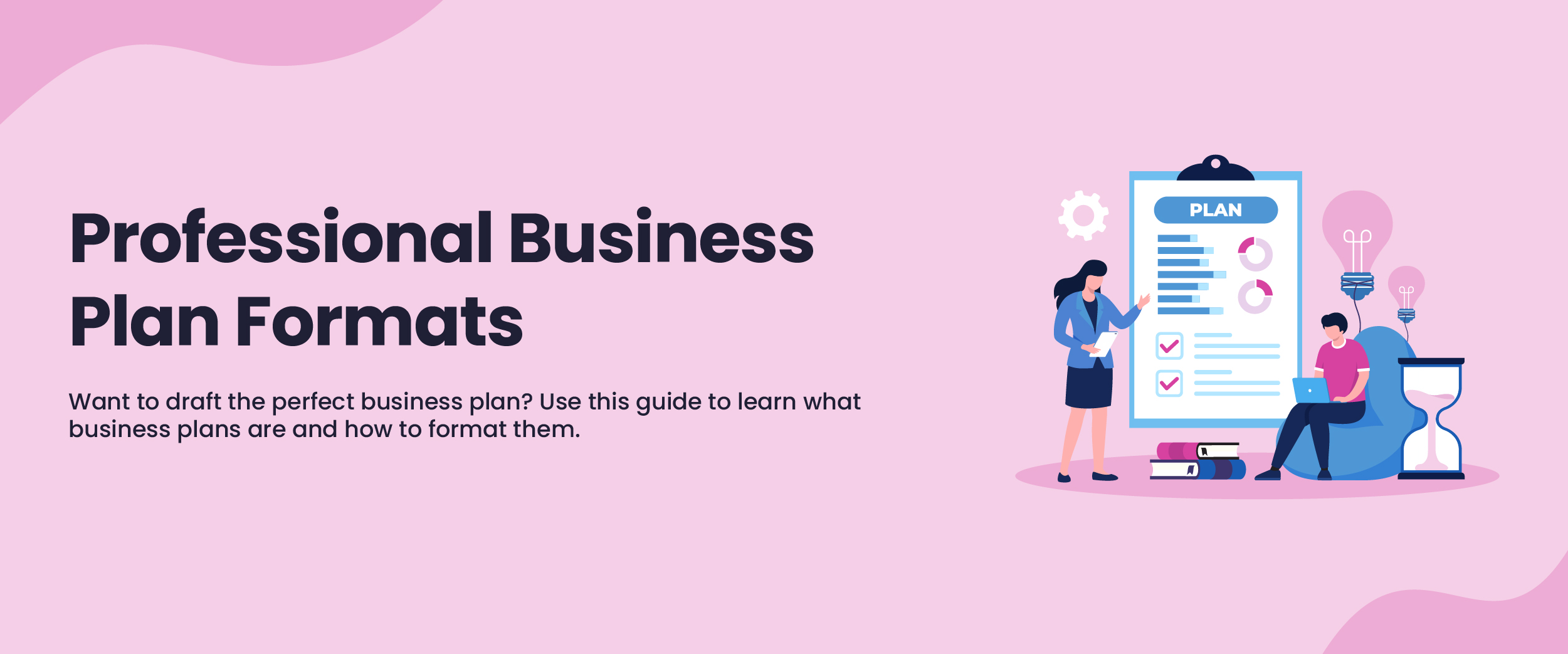The Ultimate Guide to Creating Investor-Friendly Business Plans [Format Guide]

Are you an aspiring entrepreneur wondering what a business plan should look like and how to create one? A well-structured business plan is an essential part of any successful venture. But it may seem challenging to give shape to your business idea and not miss out on any important details.
In this blog, we’ll discuss the key elements of a business plan and provide you with a useful business plan format with sample statements to help you on your way.
Business Plan: An Overview
A business plan is a detailed document that outlines the objectives, strategies, and tactics of a business. It is typically used to secure investments, financing, and other forms of support from stakeholders. The document should include information such as descriptions of the company, its products and services, its customers, its marketing and financial plans, and its operational plans. Having a business plan is crucial for any business. It can ensure that everything is taken into account and that the business is well-prepared to succeed.


Business Plan Format with Sample Templates
Writing a business proposal can be tricky. Whether it is a small or large business, there are a few key elements you should consider when discussing a business strategy to enhance your business plan. This section provides sample templates that can help you streamline your unique business proposal.
1. Give an Executive Summary
An executive summary in a business plan is a brief overview that outlines the major points of the plan. It should be concise and engaging so that it captures the attention of potential investors or lenders. The summary should be in paragraphs with comprehensible headings and points. To write an executive summary, you should briefly answer the following questions (not necessarily all):
- What is the mission of your business or your company/organization?
- How did the idea of business come up?
- Who has the highest leadership?
- Which industry does the business belong to?
- What is going to be the employee base?
- What are the business’s products and services?
- What are the competitive advantages of the business in the already existing market/industry?
- What marketing strategy will be used?
- How many different operational teams are going to form?
- What is going to be the location?
- Who are the stakeholders?
- How will you fund the business?
- How much money is required to set up the business?
- What are its future financial targets?
Here is an example of an executive summary of an organic food product start-up.
“[Company Name] is a start-up business venture that specializes in the production and distribution of organic health food products. It was founded by two entrepreneurs who have 10 years of combined experience in the health food industry. The company is located in a major metropolitan area.
Our goal is to become the top provider of organic health food products in our market. We plan to do this by providing high-quality products and services and excellent customer service. We have identified some key competitive advantages that will help us succeed, including our experienced management team, our strong network of suppliers, and our commitment to innovation.”
2. Talk About the Business’s Key Products and Services
In this section, talk about the key products and services that your business plans to offer, along with their value proposition. Here, the term value proposition means why a person will care to buy your product or service. It also uncovers unexplored and potentially marketable opportunities.
Here’s a business proposal example that includes details of key products and services for an organic healthy food product start-up:
“Our business offers organic foods that are healthier and more sustainable. Our value proposition is that our customers can enjoy healthy, farm-fresh foods while feeling good about contributing to the environment. We strive to offer a wide range of products, from organic produce to organic sauces, fruit bars, and snacks.
As dietary habits have evolved, there are a significant number of people who prefer or require gluten-free products due to their health issues. We strive to produce gluten-tolerance-tested, authentic, and trustworthy gluten-free products with delivery and online ordering to make purchasing easier for our customers.”
3. Insight on Competitive Market Analysis
Business planners need to possess comprehensive knowledge of their target industry and market. Having great business analysis skills can help a business planner get a clear understanding of how to compete effectively and gain a foothold in the market. This section should cover the following information:
- Market Size: Describe the size of the industry, the expected growth rate, and the potential earnings it offers.
- Target Audience: Who are the perfect customers for your business? Include details like their age, where they live, and their preferences.
- Competitors: Write about your key competitors’ strengths and weaknesses and how you plan to counter them.
- USP (Unique Selling Point): Cite what distinguishes your product or service from the competition. What’s your marketing plan to set yourself apart from the competition?
- Price and Profit: Share what pricing scheme your business will follow and the estimated profit margin.
- Rules and Regulations: Specify any special rules or laws you must follow in your industry.
An example to describe the market analysis in the business proposal template for an organic healthy food product’s start-up will be like this:
“The health food industry in India is rapidly expanding, with a compound annual growth rate (CAGR) of 20% and an expected CAGR of 16% by 2026, equivalent to $30 billion. This growth is attributed to the increasing number of health-conscious individuals, who are expected to grow from 100 million to 176 million by 2026. Healthy snacking categories like cookies, fruit snacks, snack bars, and trail mixes are expected to experience significant growth.
Our products and services stand out due to our commitment to quality and reasonable prices. Our experienced management team, strong supplier network, and innovation are key competitive advantages. We aim to market our products to health-conscious consumers seeking organic alternatives to conventional foods, aiming to become the leading organic food supplier.”
4. Target Audience Selection
A business’s success is incomplete without fostering and developing its customer base. “You must know your customers and the customers must know you” – this should be the motto for your business.
After in-depth research on target customers, you can form the right marketing and sales strategies. The best way to identify customers is to understand their problems and needs. Simply put, your business’s products and services must solve their problems and fulfill their wants. Here’s an example to share about the target audience selection for an organic, healthy food product start-up:
“Our target audience is adults aged 18-40 who are health-conscious and interested in organic options. We will focus our marketing and sales efforts on this demographic, as they are likely to be more open to trying new products and more likely to embrace organic alternatives. Our goal is to become the leading organic food supplier for this demographic.”
5. Structure of the Company’s Management and Team
This section of the business plan template will discuss the teams and departments that will make the business run. Briefly outline the roles and responsibilities of a position and create a job posting to hire the right employee.
Here is one way to briefly mention your company’s management team structure:
We will have a CEO, COO, CFO, and other executive positions to manage the company’s operations. Several teams will be involved in running the business, including a customer service team, administration, human resources, sales and marketing team, finance team, operations team, and product development team. Each team would have its own set of roles and responsibilities.”
6. Marketing and Promotional Strategies
This is one of the most crucial parts of your business plan. The right marketing and promotional plans help spread the word about your product or service, increase overall brand awareness, capture market share, and thereby, increase the customer base, sales, and profits. Here is a brief overview of marketing and promotional strategies in your business proposal:
“Our marketing strategy is centered around a multi-faceted approach to engaging with our customers. We will create interesting and relevant content for social media platforms, optimize our website for search engines, collaborate with influencers, run targeted online ads, and send out email campaigns.
Our promotional efforts will include limited-time discounts, loyalty programs, and exclusive events to connect with our customers on a personal level. We plan to expand our outreach through partnerships with complementary businesses and attending industry events. To measure the effectiveness of our strategies, we will leverage analytics tools and gather customer feedback to make necessary adjustments. Our ultimate aim is to build trust and credibility in our brand.”
7. Details of Developing Sales Funnel
The growth strategy of a business depends heavily on its sales funnel strategy. This is because successful sales will lead to revenue growth and business expansion. An example to mention about the sales funnel in the business plan model is:
“Our sales funnel is designed to help our business generate more leads and close more sales. We will start by optimizing our online presence to increase visibility and attract potential customers. From there, we will create content and campaigns to nurture leads and build valuable customer relationships. We will then use analytics and other data-driven tactics to identify qualified prospects and target them with effective messaging and emails. Finally, we plan to use automated tools to manage the sales process from start to finish.”
8. Lay Out Your Financial Plan and Budget
This point of your business proposal will include details of the budget, balance sheet, revenue generation, cost reduction strategies, and other expenses. It should talk about the costs required to cover all business operations, management, and estimated future revenue projections. Here is a template of a business budget.
9. Add Appendix to Provide Additional Details
The appendix to a business proposal template includes extra documents that give more information about the proposal. You can put in any part that needs evidence, facts, or reports. Normally, the appendix can have these documents:
- Market research with charts and data from other sources.
- Licenses, contracts, certificates, or patent papers.
- Maps and plans for expanding the business facility.
- Contact details for team members, board members, and current investors.
- Reports and statements from quality-check experts.
- Financial documents like the balance sheet and the company’s account statements.


Conclusion
Every business needs a one-of-a-kind business plan format. It should contain all the necessary information and documents to give the reader, investors, and stakeholders a comprehensive overview of the proposed business. By taking the time to structure and create a detailed business plan, entrepreneurs, business planners, and analysts can create a clear and concise guide to help them achieve their goals. Executing a successful business plan, therefore, requires skilled professionals. If you are interested in the field of business management and helping businesses make valuable decisions, then look for work from home accounts jobs to contribute.
Have you ever drafted a business plan? Tell us in the comments below!






